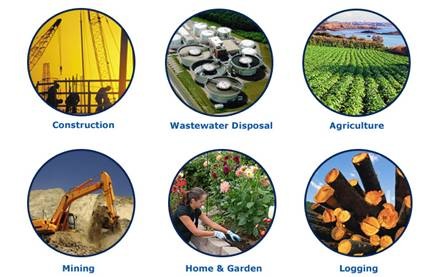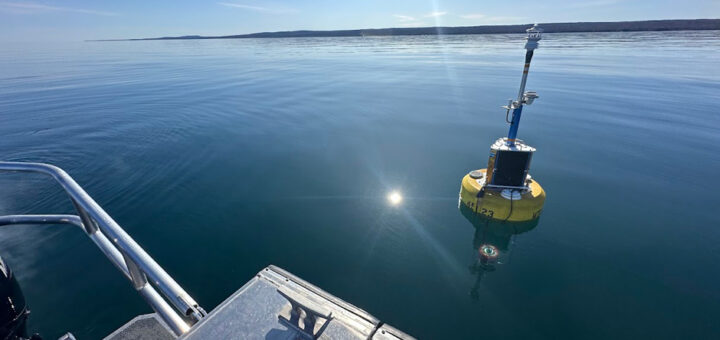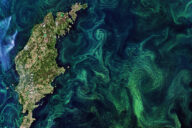Pollution
Sarah Hicks | Kent State University (pollution)
Pollution affects water quality in lakes and other freshwater resources around the globe. It can take many forms from industrial, agricultural, or municipal sources; a few common examples include pesticides, herbicides, sewage, and litter.
Lakes often contain high pollution levels relative to the surrounding landscapes and environment. Rivers and streams drain pollutants from the landscape where they concentrate in lakes and other water bodies. Aquatic species such as fish can be extremely high in contaminants as some pollutants don’t readily dissolve and dilute in water and are instead taken up into organisms. Some species of aquatic organisms are particularly sensitive to pollution; they are used as indicators of pollution and are called bioindicators. Because lakes drain a large surrounding landscape, they reflect the processes and actions that operate around them. When chemicals are spilled, they can drain into nearby streams and be transported downstream into lakes.
Point source vs. non-point source pollution
Pollution is generally categorized by how it enters a lake – either point source or non-point source pollution.
Point Source Pollution: Contaminants that enter a water body that can be traced back to a specific source, location, and offender. Point source pollution is easier to manage compared to non-point source pollution.
Non-Point Source Pollution: Contaminants that enter a water body that cannot be traced back to a specific source, location, and offender. Rather, this pollution comes from many diffuse sources and often enters in small amounts but can become concentrated in lakes and other freshwater resources.
Examples of point source pollution include dumping of industrial waste, effluent from sewage treatment facilities, illegal dumping, and other hazardous chemical deposition (e.g. nuclear waste). Heat can also be a pollutant. For example, power plants often use water to cool overheating components. Once used, this hot water is released into nearby lakes where it alters the lake’s temperature. This heat is a form of pollution because it can be harmful and kill aquatic life including sensitive fish species1. Another example of widespread pollution is the legal discharge of sewage and other chemicals. For example, Detroit, Michigan reports disposing more than 700 million gallons of wastewater daily and 150 million pounds of toxic polychlorinated biphenyls (PCBs) yearly into the Detroit River, which serves as a link between Lake Huron and Lake Erie2. Because the source of point source pollution is often identifiable, it is much easier to manage than non-point source pollution.
When pollution emerges from locations far away from a water body or there are many small, diffuse sources, it is considered non-point source. Without an identifiable source, this type of pollution is often difficult to manage; it is harder to estimate how much pollution is actually occurring and what sort of impacts it is having. Non-point source pollution includes agricultural runoff (pesticides, fertilizers, manure), acid rain, nitrate deposition, and leaching from septic tanks. Non-point source pollution accounts for most of the contamination in water systems1.

Non-point source pollution includes many activities that occur around lakes. These activities can be difficult to manage effectively yet may have extremely harmful impacts on lake water quality.
How does pollution affect lakes?
Regardless of the source, pollution can disrupt aquatic life in many ways. In general, pollution reduces water quality. It can also reduce the diversity of wildlife, especially sensitive species (see bioindicators section to learn more). Fertilizers and pesticides from agricultural and urban runoff and sewage seepage from the groundwater enter lakes and cause elevated levels of nitrates and phosphates. These can lead to harmful algal blooms and eutrophication, which can be harmful to both aquatic life and human health. Industrial runoff can contain heavy metals, such as lead and mercury, which can find their way into the food chain. This can cause illness or death to fish, other animals, or humans that consume them. Sediment washed away from construction activities and urban or agricultural activity enter lakes, reducing water clarity and water quality, and can be lethal to aquatic organisms by becoming trapped in gills. Finally, atmospheric pollutants — from car exhaust pipes or industrial power generation can enter lakes as acid rain or other forms of acidic precipitation.
Managing Pollution
In order to manage pollution effectively, several questions must be answered:
- What is the source of the pollution?
- How much pollution is occurring?
- What is the projected lifetime of the pollution?
- What are the expected effects of the pollution?
Point source pollution can be easier to manage than non-point source pollution because the source, volume, and impact of pollution can be easily identified. Further, point source pollution impacts are often concentrated in one location, making remediation easier.
The level of impact from a pollutant is dependant on several properties of the particular pollutant.
First, its level of toxicity is an important consideration; some pollutants such as PCBs are highly toxic, meaning only a small amount is enough to harm humans and other organisms. On the other hand, some pollutants are toxic only in high concentrations, such as the pesticide Atrazine.
The amount of a particular pollutant in the environment is also an important factor regulating its effects. For example, if a particular chemical is only mildly toxic to fish, yet is found in the environment in high amounts because of a widespread application, it can be very harmful.
Finally, the lifetime of a pollutant – the length of time it is expected to stay in the environment – is another vital factor. Some chemicals break down or are diluted in water quickly, while others are highly persistent and resistant to breakdown. Examples of long-lived pollutants include chemicals DDT, PCBs, and mercury; these chemicals are highly resistant to degradation and can remain for decades after their release has stopped. For example, studies from the Great Lakes in the U.S. and other important lakes show that while the release of these toxic pollutants had decreased2 their levels in fish and other aquatic organisms have actually increased because they stay in the environment and accumulate in fish over long periods of time3. Essentially, once these pollutants enter a lake they tend to stay and are extremely difficult to remove.
What can you do?
Efforts have been made to reduce pollution in U.S. waterways for decades, with some success stories. However, new compounds and chemicals are released into the environment all the time. Pollution can be managed in a number of ways at levels ranging from the individual to the community, state, and federal level. Individuals can take action by disposing waste properly, planting trees to reduce sediment runoff, promoting water filtration, leaving wilderness areas intact, reducing fertilizer and pesticide usage on lawns and gardens, and selectively purchasing goods and services from environmentally responsible companies.
Federally, the Clean Water Act protects many U.S. waterways. This legislation allows states to establish goals and standards for wastewater treatments and overall water quality1. The 1990 Clean Air Act Amendments have effectively reduced acid rain pollution. This legislation regulates sulfur and nitrous oxide compound emissions.
The Environmental Protection Agency is charged with enforcing water quality laws. In recent years, the EPA has devoted billions of dollars to remove harmful pollutants and invasive species from U.S. lakes and other waterways4. The highest priorities include cleaning up the few toxic areas that have been polluted for over 20 years, decreasing phosphorus levels (which lead to eutrophication), and protecting surrounding wetland areas. The Great Lakes have suffered dumping of industrial waste, agricultural and residential runoff, and disappearing wetlands4. Through a combination of government intervention and increased awareness of the importance and fragility of freshwater resources, pollution can be effectively managed in the future.
Sources:
- Krantz, D.& Kifferstein, B. (n.d.). Water Pollution and Society. Retrieved February 26, 2010, from University of Michigan website: http://www.umich.edu/~gs265/society/waterpollution.htm
- Mahler, B.J., Van Metre, P.C., & Callender, E. (2006). Trends in Metals in Urban and Reference Lake Sediments Across the United States, 1970-2001 Environmental Toxicolgy and Chemistry, 25 (7), 1698-1709.
- Toxic Contaminants in the Great Lakes. (2000, September, 27) Retrieved February 28, 2010, from Sea Grant: Great Lakes Network website: http://www.seagrant.wisc.edu/communications/greatlakes/glnetwork/toxics.html#tainted
- Federal Officials Unveil Blueprint for Great Lakes. (2010, February 21) Retrieved February 27, 2010, from The New York Times website: http://www.nytimes.com/2010/02/22/science/earth/22epa.html?ref=politics
- Cusheon Lake Stewardship. Pollution Problems. 2010. Retrieved online at: http://www.cusheonlakestewardship.com/polution-problems.htm









